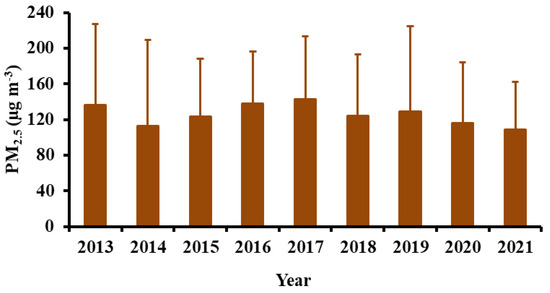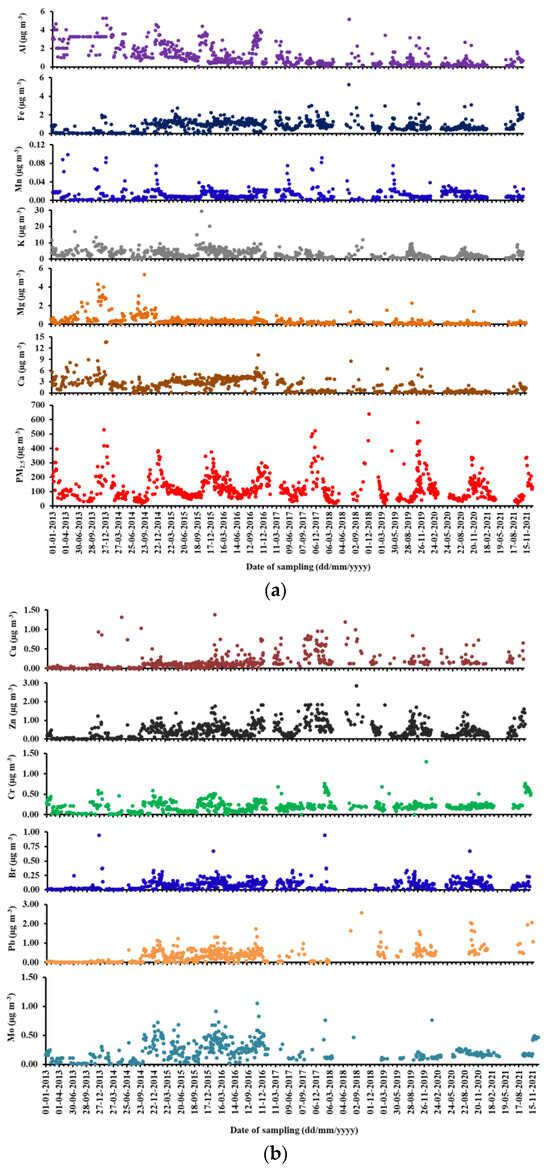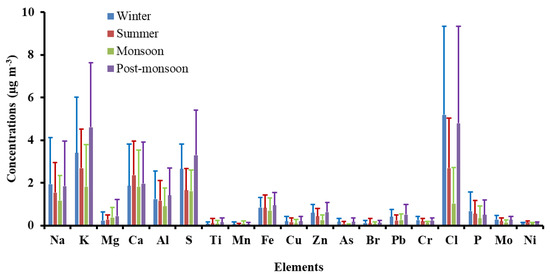Abstract
On the basis of a long-term analysis (2013–2021), we report the inter-annual and seasonal concentrations and possible sources of trace elements (TEs) in PM2.5 over Delhi, India. In all the PM2.5 samples, 19 major and trace elements were extracted: Na, Al, Fe, Ti, Mg, Cu, Zn, Cr, Mn, Ni, As, Mo, Cl, P, S, Ca, K, Pb, and Br. The total annual mean concentration (∑El in PM2.5) of major and trace elements was 17.4 ± 3.1 µg m−3, accounting for 13.9% of PM2.5. The enrichment factor (EF) and IMPROVE model analysis indicate the seasonal abundance of mineral/soil dust (Fe, Al, Ti, Na, Ca, and Mg) at the sampling location of Delhi. During the sampling period, the highest loading of trace elements was recorded in 2015 (19% of PM2.5) and the lowest in 2020 (9% of PM2.5), possibly due to limited activity during COVID-19 lockdown/unlock times. The major sources of elements (in PM2.5) were extracted by a principal component analysis (PCA) as crustal/soil/road dust, vehicular traffic/industrial emissions, combustion (solid + fossil fuels), and sodium magnesium salts in Delhi.
1. Introduction
Trace elements (TEs) contribute a small fraction to fine mode particulate matter (PM) in comparison to other chemical species (organic and inorganic) and affect the quality of ambient air and human well-being [1,2,3]. Apart from natural sources, particulate-bound major and trace elements emit from various anthropogenic activities such as dust particles (crustal, long-range transportation, and construction activities); the combustion of fuels (biomass and fossil fuels); industrial and vehicular emissions, etc. [3,4,5,6]. Majorly, PM-bound elements are non-volatile in nature and are not affected by their transportation to or from local or other regions [1,2,5,6,7,8]. Previous studies [2,7,8] report that the inhalation of elements like Zn, As, Fe, Hg, Mn, Pb, Cu, Cr, and Ni, which can be emitted from diverse sources, has detrimental effects (poisonous and mutagenic) on human well-being. In this paper, we report the annual and seasonal composition of elements and their possible sources of PM2.5 in the megacity of Delhi, India, on a long-term basis.
2. Materials and Methods
Delhi, the capital city of India, is considered one of the most polluted cities in India and the world [9]. For the long-term assessment of the elemental composition of PM2.5, fine particulate samples (PM2.5) were collected at the CSIR–National Physical Laboratory (28°38′ N, 77°10′ E; 218 m amsl), New Delhi, from January 2013 to April 2021. Delhi experiences four distinct seasons (classified by the India Meteorological Department): winter (January–February; JF), summer (March–May; MAM), monsoon (June–September; JJAS), and post˗monsoon (October–December; OND). In our previous publication [10], the sampling location is described in detail.
PM2.5 samples (n = 756) were collected on pre-baked quartz filters for up to 24 h by a fine particle sampler operated at a flow rate of 1 m3 h−1 (accuracy: ±2% of FS). A Wavelength-Dispersive X-ray Fluorescence Spectrometer (WD-XRF; ZSX Primus, Rigaku, Tokyo, Japan) was employed to identify 19 elements (Na, Al, Fe, Ti, Br, Cu, Zn, K, Mn, Cr, Ni, Mo, Mg, Cl, P, S, Pb, As, and Ca) in all the PM2.5 samples (Mo and Ni were traced in few PM2.5 samples). Detailed information about the estimation of elements, the working principle of the instrument, and the calibration standards used are available in Sharma et al. [3]. A principal component analysis (PCA) was applied to examine the possible sources of elements in Delhi.
3. Results and Discussion
The annual mean concentrations of PM2.5 are depicted in Figure 1, and the time-series plots of major and trace elements of PM2.5 are presented in Figure 2a,b. The mean annual concentration of PM2.5 was 127 ± 58 µg m−3 with a maxima of 143 ± 70 µg m−3 (in 2017) and a minima of 109 ± 53 µg m−3 (in 2021) during the entire sampling period. The non-significant decreasing trend (y = −1.63x + 133.9; R² = 0.15) in annual concentrations of PM2.5 was observed from 2013–2021. The annual mean concentrations of PM2.5 was recorded more than three times that of National Ambient Air Quality Standards (NAAQS, annual level: 40 µg m−3). Out of the 19 elements, the higher concentrations of major elements such as K, Al, Fe, Ca, Na, Mg, and S in PM2.5 were recorded in Delhi. Other studies also reported similar observations [1,5,10,11,12,13,14]. The highest loading of elements was recorded in 2015 (19% of PM2.5), and the lowest in 2020 (9% of PM2.5) might be due to limited activity during COVID-19 lockdown/unlock times. The total concentrations (∑El) of elements in PM2.5 accounted for 13.9% of PM2.5 during 2013–2021 in Delhi. Similar observations were reported by Jain et al. [10] and Rai et al. [1] with a 17% and 19% contribution of elements in PM2.5 over Delhi.

Figure 1.
Annual mean concentrations of PM2.5 in Delhi, India.

Figure 2.
(a). Time-series plots of major elements present in PM2.5 in Delhi from 2013–2021. (b). Time-series plots of trace elements present in PM2.5 at Delhi from 2013–2021.
Seasonal elemental concentrations (Al, Fe, Ti, Cu, As, Zn, Mn, Cr, Ni, P, Mo, Na, Mg, Cl, S, K, Pb, Br, and Ca) of PM2.5 are depicted in Figure 3, whereas the seasonal percentage contribution of elements in PM2.5 is illustrated in Table 1. The percentage of elements contributing to PM2.5 during the winter, summer, monsoon, and post-monsoon seasons was computed as 12.9%, 16.9%, 16.6%, and 11.7%, respectively. A higher loading of elements in PM2.5 during the summer (16.9%) and monsoon (16.6%) seasons is due to occasional dust storms, higher wind speeds, and long-distance transit of pollutants from the Thar desert and neighboring areas to the receptor site of Delhi [4,15,16]. The higher loading of Al, Fe, Ti, Ca, and Na in PM2.5 found during all the seasons at the sampling site is attributable to mineral/soil dust [14,15,16]. During the post-monsoon season, a higher concentration of Cl was found, which could be attributed to the combustion of coal and the burning of wood, plastic, paper, diesel fuels, etc. [14,17,18].

Figure 3.
Pooled seasonal mean concentrations (2013–2021) of major and trace elements (TEs) in PM2.5 during all seasons in Delhi.

Table 1.
Total elemental concentrations (∑El) of PM2.5 (in µg m−3) in Delhi, India.
For the source apportionment of PM2.5, a PCA was used and identified the five sources of PM2.5 in Delhi. During all the seasons, the heavy loading of crustal elements (Al, Na, Ca, Ti, Fe, and Mg) indicated crustal/soil/road dust as the first factor of PM2.5. An IMPROVE model analysis and EFs suggest an abundance and crustal origin of these elements (Al, Na, Ca, Fe, Ti, and Mg) [16,19]. The second factor extracted the combustion source (biomass burning + fossil fuel combustion) of PM2.5 due to the substantial loading of K, S, and Cl [3,17,18]. The third factor indicated the relatively heavy loading of Pb, Cu, Mn, and Zn and was extracted as a source of vehicular emissions (VEs) [4,16,20]. The fourth factor of PM2.5 was examined as industrial emissions (IEs) due to the elevated loading of Cr, Cu, Zn, Ni, Fe, Br, and Ti [10,21,22]. The fifth factor of PM2.5 was resolved as soil dust + VEs + IEs [10,19].
4. Conclusions
This paper presents the seasonal, long-term annual concentrations and sources of major & trace elements in PM2.5 over Delhi, India. During the entire study period, 19 elements (Na, Mg, Ca, Mn, Al, Fe, Ti, Cu, Zn, Cr, Ni, As, Mo, Cl, P, S, K, Pb, and Br) were extracted from PM2.5 samples, which accounted for 13.9% of the PM2.5 mass concentration (127 ± 58 µg m−3). An IMPROVE model analysis implies the seasonal accumulation of soil dust (SD) in the sampling location of Delhi. Crustal/soil/road dust, vehicular traffic/industrial emissions, combustion (solid + fossil fuels), and sodium magnesium were resolved as the major sources of elemental concentrations of PM2.5 in Delhi. This long-term study on the elemental composition of PM2.5 will be useful for policymakers in mitigating and improving the ambient air quality and human health.
Author Contributions
Conceptualization, investigation, supervision, writing—original draft preparation, writing—review and editing, funding acquisition, S.K.S.; sample collection, chemical analysis, data curation, writing—review and editing, S.G., R.B., A.R. and M.R. All authors have read and agreed to the published version of the manuscript.
Funding
The authors acknowledge the CSIR–National Physical Laboratory, New Delhi for financial support for this study (OLP-230332).
Institutional Review Board Statement
Not applicable.
Informed Consent Statement
Not applicable.
Data Availability Statement
The datasets are available with the corresponding author and will be provided on reasonable request.
Acknowledgments
The authors are thankful to the Director of CSIR–NPL, New Delhi, and the Head of the Environmental Sciences and Biomedical Metrology Division, CSIR–NPL, New Delhi for their encouragement.
Conflicts of Interest
The authors declare no conflicts of interest.
References
- Rai, P.; Furger, M.; El Haddad, I.; Kumar, V.; Wang, L.; Singh, A.; Dixit, K.; Bhattu, D.; Petit, J.E.; Ganguly, D.; et al. Real-time measurement and source apportionment of elements in Delhi’s atmosphere. Sci. Total Environ. 2020, 742, 140332. [Google Scholar] [CrossRef]
- Joshi, P.; Dey, S.; Ghosh, S.; Jain, S.; Sharma, S.K. Association between acute exposre to PM2.5 chemical species and mortality in megacity Delhi, India. Environ. Sci. Technol. 2022, 56, 7275–7287. [Google Scholar] [CrossRef]
- Sharma, S.K.; Mandal, T.K. Elemental composition and sources of fine particulate matter (PM2.5) in Delhi, India. Bull. Environ. Contam. Toxicol. 2023, 110, 60. [Google Scholar] [CrossRef] [PubMed]
- Jain, S.; Sharma, S.K.; Vijayan, N.; Mandal, T.K. Seasonal characteristics of aerosols (PM2.5 and PM10) and their source apportionment using PMF: A four-year study over Delhi, India. Environ. Pollut. 2020, 262, 114337. [Google Scholar] [CrossRef]
- Rabha, S.; Subramanyam, K.S.V.; Sawant, S.S.; Saikiya, B.K. Rare-earth elements and heavy metals in atmospheric particulate matter in an urban area. ACS Earth Space Chem. 2022, 6, 1725–1732. [Google Scholar] [CrossRef]
- Chakraborthy, A.; Gupta, T.; Mandaria, A.; Tripathi, S. Trace elements in ambient aerosols and size resolved for droplets: Trends, enrichment, and risk assessment. Heliyon 2023, 9, e16400. [Google Scholar] [CrossRef] [PubMed]
- Pope, C.A.; Ezzati, M.; Dockery, D.W. Fine-particulate air pollution and life expectancy in the United States. N. Engl. J. Med. 2009, 360, 376–386. [Google Scholar] [CrossRef]
- Colonna, K.J.; Kotrakis, P.; Kinney, P.L.; Cooke, R.M.; Evans, J.S. Mortality attributable to long-term exposure to ambient fine particulate matter: Insight from the epidemiologic evidence for understudied locations. Environ. Sci. Technol. 2022, 56, 6799–6812. [Google Scholar] [CrossRef]
- Bhat, M.Y. Environmental problems of Delhi and Governmental Concern. In Global Issues and Innovative Solutions in Healthcare, Culture, and the Environment; Mervio, M., Ed.; IGI Global: Hershey, PA, USA, 2020; pp. 133–167. [Google Scholar]
- Jain, S.; Sharma, S.K.; Choudhary, N.; Masiwal, R.; Saxena, M.; Sharma, A.; Mandal, T.K.; Gupta, A.; Gupta, N.C.; Sharma, C. Chemical characteristics and source apportionment of PM2.5 using PCA/APCS, UNMIX and PMF at an urban site of Delhi, India. Environ. Sci. Pollut. Res. 2017, 24, 14637–14656. [Google Scholar] [CrossRef]
- Bangar, V.; Mishra, A.K.; Jangid, M.; Rajput, P. Elemental characteristics and source apportionment of PM2.5 during the post-monsoon season in Delhi, India. Front. Sustain. Cities 2021, 3, 648551. [Google Scholar] [CrossRef]
- Sharma, S.K.; Choudhary, N.; Kotnala, G.; Das, D.; Mukherjee, S.; Ghosh, A.; Vijayan, N.; Rai, A.; Chatterjee, A.; Mandal, T.K. Wintertime carbonaceous species and trace metals in PM10 in Darjeeling: A high altitude town in the eastern Himalayas. Urban Clim. 2020, 34, 100668. [Google Scholar] [CrossRef]
- Sharma, S.K.; Mandal, T.K.; Banoo, R.; Rai, A.; Rani, M. Long-term variation in carbonaceous components of PM2.5 from 2012-2021 in Delhi. Bull. Environ. Contamin. Toxicol. 2022, 109, 502–510. [Google Scholar] [CrossRef] [PubMed]
- Choudhury, N.; Srivastava, P.; Dutta, M.; Mukherjee, S.; Rai, A.; Kuniyal, J.C.; Lata, R.; Chatterjee, A.; Naja, M.; Vijayan, N.; et al. Seasonal characteristics, sources and pollution pathways of carbonaceous aerosols and elemental composition of PM10 at high altitudes Himalayas of India. Aerosol Air Qual. Res. 2022, 22, 22009. [Google Scholar]
- Kumar, A.; Sarin, M.M. Mineral aerosols from western India: Temporal variability of course and fine atmospheric dust and elemental characteristics. Atmos. Environ. 2009, 43, 4005–4013. [Google Scholar] [CrossRef]
- Sharma, S.K.; Mandal, T.K.; Saxena, M.; Rashmi Rohtash Sharma, A.; Gautam, R. Variation of OC, EC, WSIC and trace metals of PM10 in Delhi. J. Atmos. Sol. Terr. Phy. 2014, 113, 10–22. [Google Scholar] [CrossRef]
- Singhai, A.; Habib, G.; Raman, R.S.; Gupta, T. Chemical characterization of PM1.0 aerosol in Delhi and source apportionment using positive matrix factorization. Environ. Sci. Pollut. Res. 2017, 24, 445–462. [Google Scholar]
- Chang, Y.; Huang, K.; Xie, M.; Deng, C.; Zou, Z.; Liu, S.; Zhang, Y. First long-term and near real-time measurement of trace elements in China’s urban atmosphere: Temporal variability, source apportionment and precipitation effect. Atmos. Chem. Phys. 2018, 18, 11793–11812. [Google Scholar] [CrossRef]
- Pant, P.; Harrison, R.M. Critical review of receptor modeling for particulate matter: A case study of India. Atmos. Environ. 2012, 49, 1–12. [Google Scholar] [CrossRef]
- Kothai, P.; Saradhi, I.V.; Prathibha, P.; Hopke, P.K.; Pandit, G.G.; Puranik, V.D. Source apportionment of coarse and fine particulate matter at Navi Mumbai, India. Aerosol Air Qual. Res. 2008, 8, 423–436. [Google Scholar]
- Gupta, A.K.; Karar, K.; Srivastava, A. Chemical mass balance source apportionment of PM10 and TSP in residential and industrial sites of an urban region of Kolkata, India. J. Hazard. Mater. 2007, 142, 279–287. [Google Scholar] [CrossRef]
- Perrino, C.; Tiwari, S.; Catrambone, M.; Dalla Torre, S.; Rantica, E.; Canepari, S. Chemical characterization of atmospheric PM in Delhi, India, during different periods of the year including Diwali festival. Atmos. Pollut. Res. 2011, 2, 418–427. [Google Scholar] [CrossRef]
Disclaimer/Publisher’s Note: The statements, opinions and data contained in all publications are solely those of the individual author(s) and contributor(s) and not of MDPI and/or the editor(s). MDPI and/or the editor(s) disclaim responsibility for any injury to people or property resulting from any ideas, methods, instructions or products referred to in the content. |
© 2023 by the authors. Licensee MDPI, Basel, Switzerland. This article is an open access article distributed under the terms and conditions of the Creative Commons Attribution (CC BY) license (https://creativecommons.org/licenses/by/4.0/).